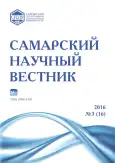Some aspects of the everyday life of officials in the Russian Empire in the beginning of XX century (based on the «Vestnik chinovnika»)
- Authors: Ospanova A.A.1
-
Affiliations:
- Orenburg State Pedagogical University
- Issue: Vol 5, No 3 (2016)
- Pages: 128-131
- Section: 07.00.00 – Historical Sciences and Archaeology
- URL: https://journals.rcsi.science/2309-4370/article/view/21971
- DOI: https://doi.org/10.17816/snv20163213
- ID: 21971
Cite item
Full Text
Abstract
This article explains the necessity of studying the historical experience of the management organization of the Russian Empire. The article contains an analysis of the situation of contemporary historiography, which feature lies in the fact that it is necessary to study not only the degree of effectiveness of the mechanisms of power, but also the factors influencing it. Among these factors occupies an important place daily serving officials, their way of life, material security, way of life. The history of everyday life – a new branch of historical knowledge, the subject of study which is the sphere of human commonness of multiple historical, cultural, political and event-and religious-confessional contexts. The focus of the study of the history of everyday life repeating, «normal» and usual, design style and way of life of the members of different social classes, including emotional reactions to events and behavior motives. One of the main sources of this study advocates periodical «Vestnik chinovnika», which allows to understand the lifestyles of officials from the "inside." Analysis of this edition allows to draw conclusions about the limited salaries, lack of financial security, which is reflected in the number of employees malfeasance. The results can serve as a basis for further study of the factors influencing the efficiency of public administration and for the study of everyday regional officials.
Full Text
##article.viewOnOriginalSite##About the authors
Alma Asylhanovna Ospanova
Orenburg State Pedagogical University
Author for correspondence.
Email: alma.ospanova2013@yandex.ru
postgraduate student of the Chair of history of Russia
Russian Federation, OrenburgReferences
- Писарькова Л.Ф. Российский чиновник на службе в конце XVIII - начале XIX века // Отечественная история. 2002. № 5. С. 33-49.
- Морякова О.В. Провинциальное чиновничество в России второй четверти XIX века: социальный портрет, быт и нравы // Вестник Московского Университета. Сер. 8. История. 1993. № 6. С. 14-29.
- Мухина E.H. Человек толпы (портрет губернского жандармского штаб-офицера эпохи Николая I // Вестник Московского Университета. Сер. 8. История. 2000. № 4. С. 34-52.
- Твердохлеб A.A., Шевырин В.М. Государственные служащие в России 1722-1995 гг.: динамика социального статуса // Социальные и гуманитарные науки. Отечественная и зарубежная литература. Сер. 5. История. M., 1995.
- Борисенок Т. Чиновничество в России XIX века: предписания, образы и стереотипы // Социально-культурные и этнические стереотипы. Материалы научной конференции. M., 1998. С. 80-86.
- Поликарпов B.C. История нравов в России от Алексея Тишайшего до Николая II. Ростов-на-Дону: Феникс, 1995. 576 с.
- Лотман Ю.М. Очерки по истории русской культуры XVIII - начала XX века. М.: Языки русской культуры, 1996. 831 с.
- Шилов Д.Н. Государственные деятели Российской империи 1802-1917. СПб: Изд-во «Дмитрий Буланин», 2001. 830 с.
- Иванов В.А. Губернское чиновничество России в 50-60-х гг. XIX в. М.: Мысль, 1998. 235 с.
- Медушевский А.Н. Утверждение абсолютизма в России. Сравнительно-историческое исследование. М.: Текст, 1993. 320 с.
- Миронов Б.Н. Социальная история России периода империи (XVIII - начало XX в.). СПб.: Изд-во «Дмитрий Буланин». 2003. 368 с.
- Любичанковский С.В. Губернская администрация и проблема кризиса власти в позднеимперской России (на материалах Урала, 1892-1914 гг.). Самара, Оренбург: ИПК ГОУ ОГУ. 2007. 750 с.
- Любичанковский С.В. Мифы об эффективности местного государственного управления позднеимперской России и их критика // Вестник ОГУ. 2006. № 7. С. 99-105.
- Вестник чиновника. 1912. № 24. С. 7.
- Вестник чиновника. 1912. № 17. С. 3.
- Вестник чиновника. 1912 № 10. С. 11.
- Вестник чиновника. 1912. № 12. С. 4-5.
- Вестник чиновника. 1912. № 38. С. 4.
- Вестник чиновника. 1913. № 23. С. 8.
- Вестник чиновника. 1913. № 40. С. 7.
Supplementary files






